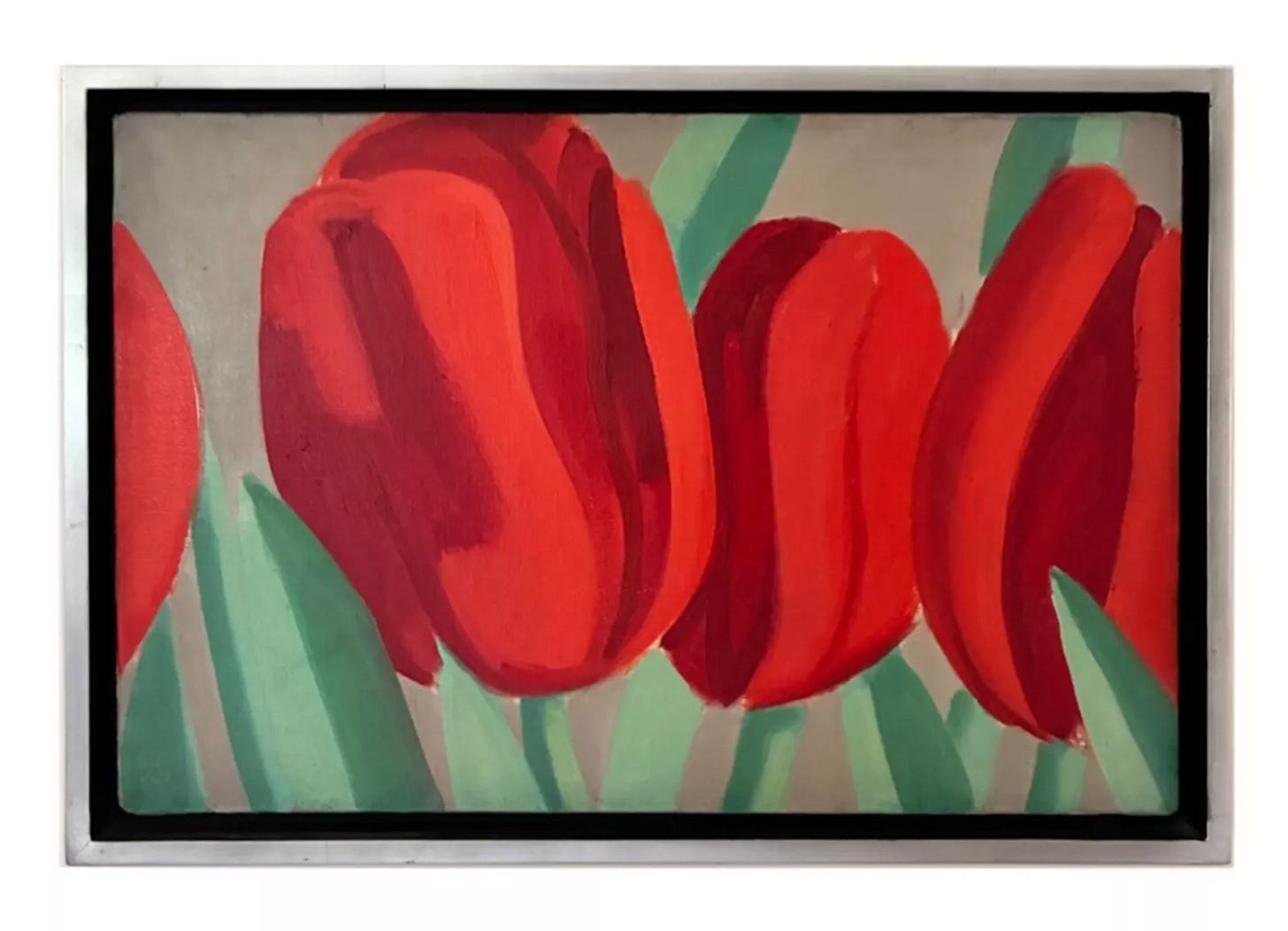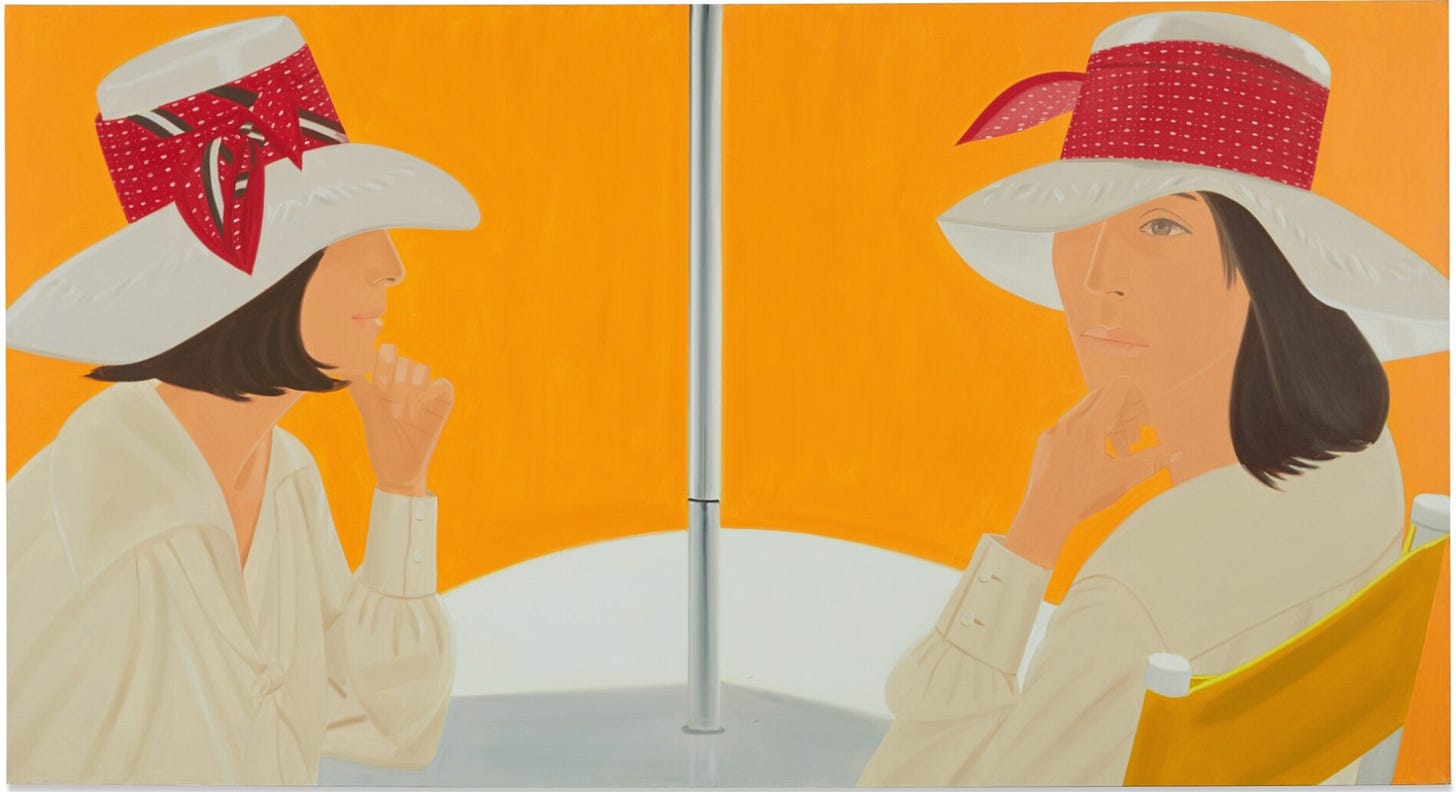Alex Katz's Revolutionary Tulip Paintings from the 1960s and the State of His Market
The Revolutionary Impact of Alex Katz's 1960s Tulip Paintings and His Current Market Position
Weekly writing about the art market and the convergence of art and technology. By day, I’m a partner at the Robert Fontaine Gallery and a data science consultant. By night, I write Artxiom, ideas at the intersection of art, technology, and finance.
If you haven’t subscribed, join today by subscribing here:
Alex Katz's Revolutionary Tulip Paintings from the 1960s and the State of His Market
While Abstract Expressionism dominated the American art scene and conceptual art was beginning to emerge, Alex Katz was quietly revolutionizing figurative painting with an unexpected subject, tulips. In the 1960s, when painting flowers could have seemed hopelessly traditional, Katz transformed this classical motif into something entirely modern, creating works that would influence generations of artists and help establish him as a crucial bridge between mid-century modernism and contemporary art.
Alex Katz, at 98, stands as one of America's most enduring contemporary artists, known for his bold, graphic portraits and landscapes that bridge the gap between Abstract Expressionism and Pop Art. His deceptively simple paintings, featuring flat planes of color, cropped compositions, and subjects ranging from his wife Ada to Maine flowers have influenced generations of artists while maintaining remarkable market strength.
Katz has been painting flowers since the 1960s, often during summer residencies in Maine. Rather than working from photographs or memory, he painted these subjects as he encountered them, developing an intimate knowledge of their forms, colors, and seasonal changes. This direct engagement gave his tulip paintings an immediacy and authenticity that set them apart from more conceptual approaches to still life. The series represented a bold departure from the gestural, emotional intensity of Abstract Expressionism that had defined the art scene in New York. Instead, Katz offered something simple, flattened depictions of tulips. (Fig. 3) What made these works radical was not just the subject matter, but the approach. Katz stripped away unnecessary detail, presenting tulips as bold, graphic forms against neutral backgrounds. The cropped, flattened composition pays homage to Japanese art, reflecting his sophisticated understanding of how Eastern aesthetics could influence Western painting traditions.
The tulip series from the 1960s anticipated many of the characteristics that would define Pop Art: the emphasis on clear, bold imagery; the use of flat, commercial colors; and the enlargement of everyday subjects to monumental scale.However, Katz's approach differed significantly from Pop artists' fascination with consumer culture and mass media. His tulips maintained a connection to direct observation and traditional painting techniques, even as they embraced the visual language of commercial design. This positioning made his work uniquely influential, offering an alternative to both the introspective intensity of Abstract Expressionism and the ironic detachment of Pop Art. Katz's technique in these works was innovative; rather than building up texture or visible brushwork, he applied paint in smooth, even surfaces that emphasized the graphic qualities of his compositions, requiring extraordinary skill and confidence.
The tulip paintings of the 1960s established themes and approaches that would define Katz's entire career. They demonstrated how traditional subjects could be revitalized through modernist techniques, how observation could be combined with sophisticated formal strategies, and how paintings could be both beautiful and intellectually rigorous. Today, as interest in painting continues to resurge, Katz's 1960s tulip paintings look remarkably fresh. They offer a model for how artists can honor traditional subjects while creating genuinely contemporary art, proving that innovation often comes not from abandoning the past, but from looking at it with fresh eyes.
Alex Katz (b.1927)
Red Tulips, 1967
Oil on Canvas
12 x 18 inches
Signed front left
Provenance:
-Irving Galleries, Palm Beach, Florida
For more information about this work, inquire below:
Alex Katz’s Market Analysis
At 98 years old, Alex Katz has achieved something remarkable in the art world, sustained market growth and institutional recognition that spans over six decades. His market performance reflects not just artistic achievement, but a unique position as one of the few living artists whose work bridges multiple generations of collectors and consistently performs well at auction. His extensive body of work, rather than diluting his market value, has created multiple entry points for collectors at different price levels.
The Katz market operates on multiple levels:
Prints and Multiples: Alex Katz prints sell for a wide range, typically between $10,000 and $100,000, with some limited editions or rare works surpassing $100,000. This segment provides accessibility for emerging collectors while maintaining strong value appreciation.
Paintings: Alex Katz paintings prices start in the tens of thousands and can easily exceed $500,000, reflecting the high demand for his work. His large-scale oil paintings can command six figures at auction, with some even surpassing $1 million. In 2019, Phillips London sold Blue Umbrella I (Fig. 4) for a record of $4.1 million, and in 2020, Sotheby’s New York sold The Red Band (Fig. 5) for $ 3.2 million.
Several factors indicate a robust and mature market for Katz:
Volume and Liquidity: With nearly 5,000 auction results recorded, Katz enjoys excellent market liquidity providing collectors with confidence in both buying and selling his work.
Institutional Support: Major museums worldwide hold Katz works, providing crucial institutional validation that supports long-term value stability. The Alex Katz retrospective "Gathering" at the Guggenheim Museum (October 2022 - February 2023) (Fig. 6) created a dramatic surge in the artist's market performance. The exhibition considerably stirred his auction market and the number of transactions shot up to reach an all-time high. The Guggenheim's institutional endorsement repositioned the 98-year-old artist from a respected artist to a vital contemporary force, fundamentally altering market perception and driving increased interest across all segments of his work, from prints to major paintings.
Cross-Generational Appeal: Unlike many contemporary artists whose appeal may be generational, Katz attracts both established collectors who remember his rise in the 1960s and younger collectors drawn to his graphic sensibility and contemporary relevance.

Rather than experiencing dramatic boom-bust cycles, Katz's market has proven to be consistent and shown a steady growth over decades. This stability makes his work attractive to both passionate collectors and those viewing art as a form of investment. Large-scale paintings, particularly portraits from the Ada series and his signature floral works, command the highest prices. Works from the 1960s-1980s, representing his mature period, are especially sought after. Also, his robust print market provides an important foundation, allowing collectors to "trade up" within the artist's oeuvre while maintaining market engagement.
In conclusion, the Katz market appears well-positioned for continued strength. His influence on younger artists continues to grow, potentially expanding his collector base. The ongoing reevaluation of American art from the 1960s-1980s benefits his market position, as does the current interest in figurative painting among younger collectors.
As demand for his work continues to grow among collectors and institutions alike, Katz represents a mature, stable market with potential for continued appreciation. His work offers the rare combination of artistic significance, market liquidity, and price stability that defines truly blue-chip contemporary art.
Thanks for reading! Subscribe here to receive Artxiom in your inbox each week:







